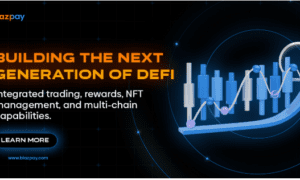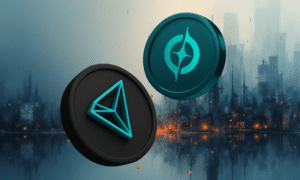What Is a Web3 Wallet, and How Can Brands Use One?
Almost every web3 user has a cryptocurrency wallet today. Many projects, both in and outside the cryptocurrency sphere, deal with wallets in one way or another. This can be reflected, for example, in the fact that when visiting your site, the client will be able to link their crypto wallet and pay with crypto, not a credit card.
Some projects prefer to create their own wallets, offering them to users as part of a set of services. For example, Swisstronik, OKX or Coinbase. Our team helps with organizing any work with specifically Web3 wallets, so we will share our experience of what they are and how to create them.
What is a Web3 Wallet?
A Web3 wallet is a tool that allows users to store their crypto assets without needing intermediaries. But there is more to it than just storage. You also get to securely manage and interact with decentralized ecosystems like blockchain, cryptocurrency, NFTs, and DeFi.
Web3 wallets have a few new features that differ them from Web2 options. Web3 wallets shift control to the user, allowing them to fully own their assets. Plus, they are able to interact with smart contracts and DeFi.
How Does a Web3 Wallet Work for Users?
Web3 wallets depend on and derive from the seed phrase – a set of random words, out of which the addresses and private keys are cryptographically generated. Address is a publicly visible information. Private key is a cryptographic access key, if one has access to it – one can get access to the specific address.
For users now, it is quite an easy task to get a Web3 wallet:
- Choose one that calls your name. Commonly, it is the one that works with specific or many chains, for example, Metamask, Phantom or Rabby. Or, it can be the wallet of a project like Swistronik or Coinbase.
- Install it. If we are talking about a hot wallet like Metamask or Phantom, it is installed as an extension in the browser. Many Web3 wallets have an application for the phone.
- Launch it. Launch the app and create a basic PIN code to use it on your device. It is not important as a seed phrase.
- Secure it. Add a seed phrase to secure your wallet. This will give you an opportunity to relaunch the wallet on any other device with all your assets. It is a series of 12–24 words that you must write down and never share with anyone.
- Use it. Users can use Web3 wallets to store, send, and receive cryptocurrencies and tokens securely. Plus, of course, you can interact directly with NFT marketplaces, DeFi platforms, and even games, with the help of your wallet.
Different Types of Web3 Wallets
Software (Hot) Wallets
Software-based wallets, often referred to as hot wallets, are applications or software that allow users to store, send, and receive digital assets while connected to the internet. This way wallets like MetaMask, Trust Wallet, and Coinbase Wallet work.
This is very convenient for most of the users. You don’t need to insert a physical flash drive or make several movements. Just open the wallet in the browser, and you’re done. But there are possible risks. This wallet has access to the Internet, which means it will be more vulnerable to hacking or phishing attacks.
Hardware (Cold) Wallets
Cold wallets, such as Ledger and Trezor, are physical devices used to store cryptocurrency offline. Of course, such wallets have a higher level of protection. No access to the Internet – no risks. By the way, you shouldn’t be afraid of losing such a wallet (usually they are very small, in the form of a flash drive), because the main thing is to save the seed phrase. Then you can restore the contents on another device.
Most users use wallets to store large amounts of cryptocurrency. These are the resources that you prefer to simply hold, saving in a secure place. Of course, this is inconvenient if you plan to make frequent transactions.
Custodial VS Non-custodial Wallets
In the world of Web3 and blockchain, wallets are categorized as custodial or non-custodial, based on who controls the private keys. These wallets serve different purposes and cater to different user needs:
Custodial
In custodial wallets, a third party (typically a centralized entity like an exchange or a service provider) holds and manages the private keys on behalf of the user. Users access their assets via login credentials (e.g., username and password), but they don’t have direct control over their private keys.
This type of wallet is often convenient for beginners and does not require any special skills in working with wallets, but will always have the risk of blocking or censorship (for customers). For a brand, this is a convenient option with increased control. If the business wants to completely abstract away the blockchain part, or have control over the user assets at some point – custodial wallets could be a good option.
Important! It requires top-notch security to create custodial wallets, and businesses should collaborate with expert teams or solutions to do these securely. These are the types of services we provide.
Non-custodial
In non-custodial wallets, the user holds and controls their private keys, giving them full ownership and control over their funds. These wallets are typically decentralized and do not involve a third party in the management of private keys. Examples include the familiar MetaMask, Trust Wallet, Ledger, Phantom, Enjin Wallet and others.
In such wallets, it is the users who are solely responsible for their private keys, seed phrases, and ultimately, their assets. But for inexperienced users, such wallets may require additional time to understand their functionality. Plus, if the user somehow compromises the security of his wallet or loses access to it, the responsibility will be solely on him, there will be no backup plan for recovery without a seed phrase.
How a Web3 Wallet Benefits Brands and Projects
Web3 wallet can be a useful tool in the piggy bank of a brand that is ready to use the advantages of Web3 in its activities. There are a number of brands that, in their work, come to the need to create their own Web3 wallet. Beyond asset management, crypto payment integration enables a smoother, decentralized checkout experience, opening new revenue streams for businesses. Here are some examples of such brands, and why they needed a Web3 wallet.
- Ledger is a very well-known hardware wallet company. They’ve decided that the creation of Ledger Live will expand its service to include a user-friendly software interface that supports managing crypto assets, staking, and interacting with Web3 applications. This is an example of a company for which wallets are a product, and Web3 wallet allows it to strengthen its position as a leader in both security and user-friendly interfaces.
- Enjin, a leading platform in the blockchain gaming and NFT space, needed a robust wallet to support its ecosystem. The Enjin Wallet was created to facilitate the management of cryptocurrencies and NFTs, particularly focusing on asset used within blockchain-based gaming environments and virtual worlds. Developing their own wallet for this gaming project meant being able to guarantee players assets security and solidified Enjin’s ecosystem for blockchain gaming, acting as a gateway for users to engage with in-game economies, metaverse assets, and tokenized rewards.
- Magic Eden is one of the leading NFT marketplaces, particularly known for its strong presence in the Solana blockchain ecosystem and, more recently, expanding to Ethereum and other blockchains. For an NFT marketplace, having its own wallet means having more control over what happens, offering its customers increased ease of use of the platform.
- Starbucks launched the Starbucks Odyssey program with its wallet, where customers can earn and collect NFT-based stamps, unlocking exclusive experiences and rewards. This required the brand to understand the basics of working with Web3 and organize several processes at once: both the creation of an NFT collection and the ability to operate Web3 wallets on the brand’s platform. As a result, it helped with direct engagement of the audience.
- OKX is a cryptocurrency exchange, so it needed a Web3 wallet to retain control over their ecosystems and data. OKX Wallet integrates its decentralized exchange (DEX), staking features, and NFT marketplace, giving users full access to these services without relying on third-party wallets. To this example, we can also add other wallets created by cryptocurrency exchange platforms, such as Binance or Coinbase.
In addition, Web3 wallets can be used by brands even if they do not create them, but use already created ones, providing their customers with such a service as an alternative to standard payment methods or for other purposes. Here are some successful examples of how a brand has incorporated Web3 technologies into its work, including a wallet:
- Dior, Lacoste, Tiffany – all these brands used the capabilities of Web3 to monetize models like NFTs or token sales. They tried to create virtual NFT models of their famous products or provide the ability to customize them. This will also require the implementation of a Web3 wallet and the organization of work with it and with Web3 for the brand. However, such digital goods create additional revenue beyond physical products and tap into new consumer markets in digital environments.
- Adidas launched its Into the Metaverse NFT collection, giving holders exclusive access to virtual events, early product drops, and voting rights on future brand decisions. With the help of Web3 you can build a decentralized community where users feel involved in shaping the brand’s direction, boosting engagement and loyalty. This is an example of so-called co-creation use of Web3.
If you want to use the benefits of this technology, the first task for you will be to solve how exactly you want to use the Web3 wallet. For example, start with your audience: who are they? How savvy are they when it comes to using crypto wallets and Web3? For tech-savvy users decentralized wallets like Metamask can work fine, for less tech-savvy users there are email-based wallets such as Privy, Magic Wallet etc, which can help abstract away the Web3 aspect.
Any such idea of Web3 engagement can be implemented from project development to its design and launch support. Our team can show you the latest examples from practice. Such a project, depending on the overall plan, can take from 1-2 weeks to 3-6 months to implement. Our team specializes in web3 wallet development, helping brands build secure and user-friendly wallet solutions tailored to their needs.
Experience Sneak Peek
The number of areas in which projects and brands can decide to use crypto wallets is countless. Today, Web3 wallets are used by brands whose audience is far from Web3-savvy. And it still works great.
For example, how it was with this case when we were creating a custodial solution based on Utila MPC for a real estate investment platform can serve as a good example of such a project. The business objective was to abstract the blockchain and Web3 from users, but at the same time create a transparent mechanism for investors to track real estate shares; be able to withdraw them at the end of the investment project, and also create an opportunity for investors to resell their shares.
Wallets were also needed so that the user could send deposits in cryptocurrency to the platform for further purchase of shares. When the user was verified, the platform under the hood created a wallet for him for deposits and for storing shares.
Deposits were accepted on BSC and on Tron, share tokens were exchanged on Optimism for gas efficiency. Thus, for investors who do not understand Web3 at all, a mechanism for transparent share management was created: while they were working with the platform, their actions actually caused real transactions on the public network with real-estate share tokens.
Conclusion
Web3 wallet is a tool that both businesses and their clients can use for their benefits. What makes Web3 wallets cool is the freedom and privacy they offer. Users can securely access dApps, engage in DeFi, and manage their digital assets all in one place. If you are interested in a way the Web3 wallet can benefit YOUR product, contact us.
FAQ
Is a Web3 Wallet Safe?
Yes, a Web3 wallet is generally safe, but its security depends on how users manage their private keys and seed phrases.
Can I Store NFTs in a Web3 Wallet?
Yes, you can store NFTs in a Web3 wallet. Most of the popular wallets do allow it, just check it beforehand.
Are Web3 Wallets Free?
Yes, Web3 wallets are typically free to download and use. For brands that develop wallets themselves, they are often not the core product. But they do help a lot in attracting customers.
Can Users Use a Web3 Wallet on Their Phones?
Yes, users can absolutely use a Web3 wallet on their phones. For this purpose, most Web3 wallets have their own mobile application.
Do You Help with Web3 Wallets Development?
Yes, we do. Our portfolio contains cases of creating custodial wallets, which you can read about.



































